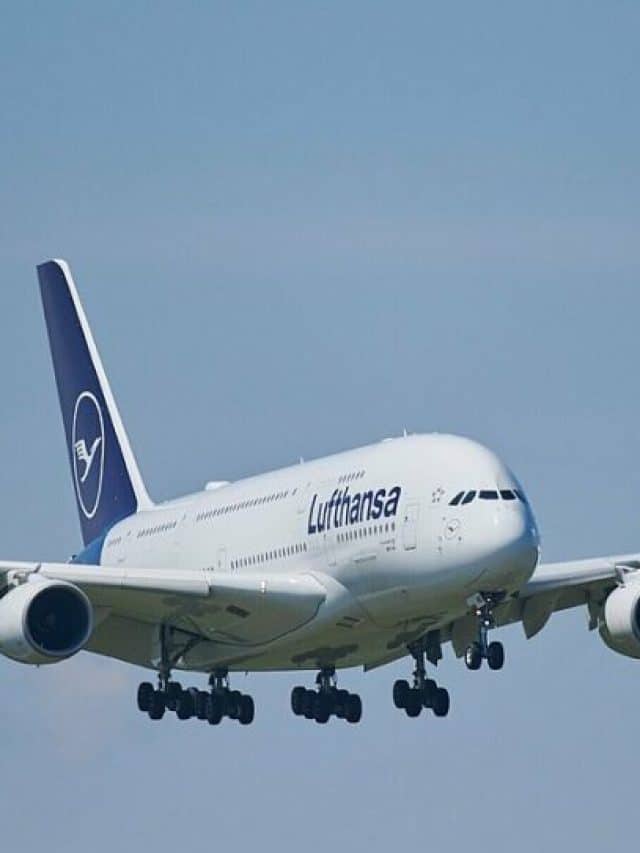Aerospace
Lufthansa is bringing back the A380 superjumbo
she is ready to fly again

Another A380 will be added to Lufthansa’s fleet from the storage facility. All of the photographs bardehle/vidicom in the post were shared by one Twitter user.
Aircraft seats have a plastic cover over them, making them appear undamaged and dust-proof. Activating once more, the Lufthansa registered D-AIMK will depart from Teruel Airport for FRA tomorrow.
Back to life: @lufthansa #A380 D-AIMK coming out of storage today @aeropuerteruel @TeruelAirport, ferried to FRA tomorrow credit Bardehle/Vidicom #avgeek pic.twitter.com/JxI520e7hc
— Andreas Spaeth (@SpaethFlies) December 1, 2022
The majority of the cockpit’s instruments and seats are taped together and appear in excellent condition.
Coming back to life today in @aeropuerteruel @TeruelAirport @TarmacAerosave is @lufthansa #A380 D-AIMK, last flown in May 2020. Ferried to FRA tomorrow it’ll be online again from late March 2023 credit Michael Lamberty #avgeek pic.twitter.com/lUyy7bsKnN
— Andreas Spaeth (@SpaethFlies) December 1, 2022
Although the seats in the business class are covered in plastic, they nevertheless appear to be in decent condition.
And the second @lufthansa #A380 D-AIMM being reactivated in @aeropuerteruel @TeruelAirport @TarmacAerosave for ferry flight at year end #avgeek credit: Michael Lamberty pic.twitter.com/3QunEIy4OD
— Andreas Spaeth (@SpaethFlies) December 1, 2022
The storage personnel is taking off the duct tape covering the interior and body of the aircraft, which appears to give the super jumbo full confidence to enter the services. Airlines are seeking for new fleets as air traffic grows, and some are using their wide-body aircraft in storage, such as the A380.

Aerospace
Boeing Transfers Rocket Stage to NASA, Paving Way for Human Moon Mission

Boeing has achieved a significant milestone by providing NASA with the second core stage of the Space Launch System (SLS) rocket.
This crucial component, crafted at NASA’s Michoud Assembly Facility (MAF), is set to propel the Artemis II crew into lunar orbit, marking humanity’s return to deep space after a 50-year hiatus.
The monumental Boeing-built rocket stage, the largest element of the Artemis II mission, will embark on a journey aboard the Pegasus barge, traveling 900 miles to NASA’s Kennedy Space Center.
Comparison of two legendary aircraft B777x vs B747 aircraft:Click here
Upon arrival, it will be meticulously integrated with other essential Artemis II components, including the upper stage, solid rocket boosters, and NASA’s Orion spacecraft within the iconic Vehicle Assembly Building. This intricate integration process is a vital step toward the eagerly anticipated Artemis II launch, slated for 2025.
“Boeing-built products helped land humankind on the moon in 1969, and we’re proud to continue that legacy through the Artemis generation,” remarked Dave Dutcher, vice president and program manager for Boeing’s SLS program. “Together, with NASA and our industry partners and suppliers, we are building the world’s most capable rocket and paving the way to deep space through America’s rocket factory in New Orleans.”
NASA, Lockheed Martin Reveal X-59 Quiet Supersonic Aircraft:Click here
The delivery of Core Stage 2 marks a significant achievement in the evolution of the SLS rocket. Towering over 200 feet and powered by four RS-25 engines, this core stage, coupled with two solid-fueled booster rockets, will generate a staggering 8.8 million pounds of thrust. This immense power is crucial to launching Artemis II and future missions into the vast expanse of space.
The SLS rocket stands unparalleled in its capability to transport both crew and substantial cargo to the moon and beyond in a single launch. Its extraordinary capacity will facilitate the delivery of human-rated spacecraft, habitats, and scientific missions to destinations including the moon and Mars, ushering in a new era of space exploration.
-

 Travel1 week ago
Travel1 week agoAir India to Expand US Operations with Three New Routes After a Decade
-

 Travel2 weeks ago
Travel2 weeks agoWhy We Should Avoid These Stamps in a Passport
-

 Airlines1 month ago
Airlines1 month agoInvestigations Reveal Fake Chinese Titanium in Boeing and Airbus Jets
-

 Tech4 weeks ago
Tech4 weeks agoChina’s CATL Plans 1,800-Mile Electric Plane Launch by 2027
-

 Airport3 days ago
Airport3 days agoTop 10 Largest Airports in the World by Size
-

 Aerospace4 weeks ago
Aerospace4 weeks agoChina’s Fighter Jets Turn Wings into Autonomous Drones
-

 Airlines4 days ago
Airlines4 days agoAir India Rolls Out A350s for Delhi-New York JFK and Newark Routes
-

 Defence3 weeks ago
Defence3 weeks agoBoeing Enhances Chinook with New Engines and Block II Upgrades at $96 Million







